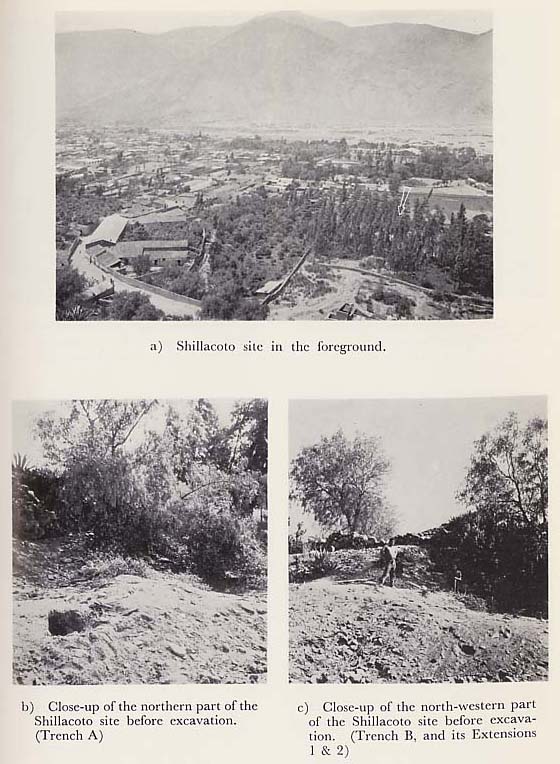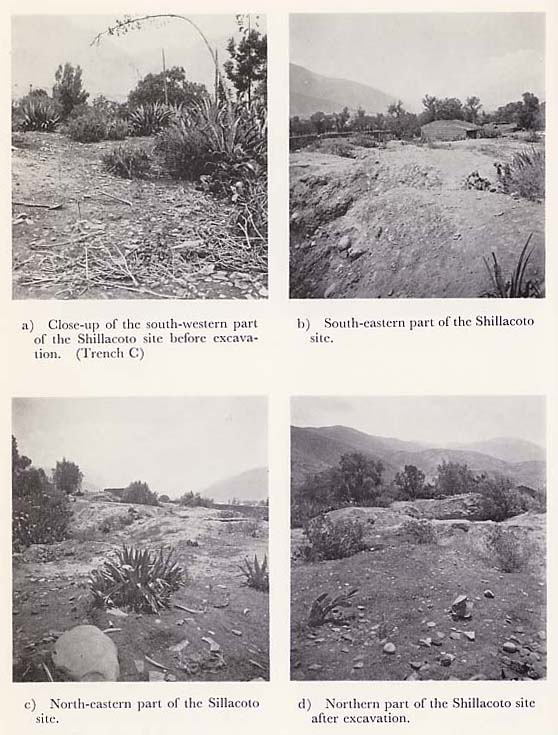The Tokyo University Expedition to the Andes has been conducting archaeological investigations of various sites in the Huallaga River basin with special consideration of Kotosh site found on the Central Highlands of Peru, for a period of ten ycars, with the purpose of inquiring into problems concerning the origins and development of ancient civilization in the New World and especially in the Andes area. As a result, the phase of the Chavin culture in this area and the existence of various pre-Chavin cultures were clarified. The discovery of a Temple belonging to the pre-ceramic period was especially valuable in regard to the investigation of the birth and origins of agricultural civilization. In addition, the Kotosh site enabled identification of the several cultural phases which followed the Chavin culture and the chronological sequence of all the cultures from the pre-ceramic period to the Formative period which had not previously been known for the highland area was ascertained.
Up to tills point, the main tusk of the Tokyo University Expedition has laid stress on definition of the. chronology, so it is difficult to state that. a complete and exhausive study of the caracteristics of and relation between the various cultures has been carried out, but henceforth it is felt that it is necessary to study the ancient cultures of the Andes area more deeply with more essential and definite content, and also from a different point of view rather than the investigation of chronology alone.
The inquiry into the various problems surrounding the agricultural civilization in the Andes region is the same as the inquiry into the origins and development of the Chavin culture. Moreover, the origin of the Chavin culture is naturally related to the investigations into the various cultures which preceded the Chavin culture and therefore those investigations into pre-Chavin cultures which aim at definition of Kotosh and the surrounding area and the research into the temple culture of the pre-ceramic period have an extremely important meaning.
In Kotosh, three cultural phases which preceded the Chavin culture were clarified-Kotosh-Kotosh, Kotosh-Wairajirca, and Kotosh-Mito. Amongst these, the Kotosh Period culture was situated stradgraphically directly beneath the Chavin culture and at the same time we could recognize the existence of several special cultural elements which were connected with the Chavin culture. For example; stirrup spouts, plain rocker stampings, curvilinear designs such as the 'cloud shape', and zoned surfaces of black paint on red defined by broad-line incisions are the most remarkable Chavinoid traits appeared in Kotosh Grooved. The highly polished black surfaces of Kotosh Black Polished Incised somewhat suggest that of Classical Chavin pottery. (Izumi and Sono, 1963, p. 155).
On the other hand, the Kotosh Period strongly maintained the traditions of the preceding Wairajirca Period in terms of ceramic ware in both shape and decoration and we believe that the relationship between the two was because the Kotosh Period culture probably developed directly on the cultural base of the Wairajirca Period. The Wairajirca Period at Kotosh equals the initial ceramic period with the first appearance of pottery during this period. However, the most important and interesting point is the relationship between this culture and the pre-ceramic culture which was located stratigraphically at the lowest level, though unfortunately this can not be examined completely, owing to the lack of available data. In addition, the meaning symbolized by " The Temple of the Crossed Hands " which is one of the constructions of the Mito Period, can not be clearly understood.
However, through the general investigations carried out on the Kotosh site and various other sites in the Huallaga River basin, it was confirmed that the existence of pre-Chavin cultures in the highland area has a very important part to play in the consideration of the origin of the Chavin culture.
With regard to the Shillacoto site, Julio C. Tello made a survey from the Amazon tropical jungle to the Montaña area on the eastern slope of the Andes in 1935, following his belief that the Chavin culture has originated in this area, and at the same time, he investigated several sites in the area surrounding Huanuco and not only pointed out Kotosh but also the existence of the Shillacoto site (Tello, 1942, pp. 635-36, 710). Also a general investigation was carried out by the Tokyo University Expedition in 1958 (Ishida, et al., 1960, pp. 299-300, 473) and in 1966, although on a small scale, excavations were made at this site. At that time, tombs belonging to the Kotosh Period were discovered and in addition a large number of potsherds of the Kotosh and Wairajirca Periods were collected. Following this in 1967, one member of this team, CHIAKI KANO during his appointment as anthropology professor at Huanuco University conducted excavations at this site as part of the students' archaeological field training, and this time, a temple construction was discovered which belonged to the Mito Period. Moreover, in 1969, the work of excavation was taken over and carried on by the Tokyo University Expedition. This book is the report covering the period from 1967 to 1969.
The purpose of the investigations of the Shillacoto site was the independent verification of the chronological sequence of cultures which had been found at Kotosh and a more definite study of the characteristics of the Formative culture of the Andes region, centered about the Chavin culture, by finding the relation between this, Kotosh and other sites. Considering the result, this site served our purpose admirably.
The Shillacoto site is located in a corner of Jirron San Martin in the outskirts: on the south side of modern Huanuco City. The topographical features and the natural surroundings of the site have already been described in great detail in the Kotosh report Izumi and Sono, 1963, pp. 15-21), so we will limit ourselves here to a simple account. About 250 meters to the east of Shillacoto flows the Huallaga River and this river has its source in the Junin Plateau at a height of 4,000 meters above sea level, flows in a south to north direction on the eastern slopes of the Andes and empties itself into the main stream of the Amazon. On the other hand, to the south of thc site there is the Higueras River which lias its source in the Puna region near the Abra Ayopiteg Pass also at a height of 4,000 meters above sea level. This flows from west to east and joins the Huallaga River. On either side of the Higueras River is a U-shaped valley but at the point of confluence of the two rivers it suddenly widens out into a flat basin in which Huanuco City is located. Shillacoto is about 300 meters to the north-cast of the point of confluence. Moreover, on the opposite south-western side of the confluence from Shillacoto are located Marabamba, Paucarbamba and some other remains. The Kotosh site is located 5 Km upstream from. Huanuco on the right bank of the Higueras River, while some 20 Km. from Huanuco on the Huallaga River arc the sites at Wairjirca and Sajarapatac. All of these are important sites belonging to the Formative Period. In addition, the cave site of Cueva de Las Lechuchas was discovered near Tingo Maria in the Selva Zone downstream on the Huallaga River (Lathrap, 1963), as well as the Yarinacocha site discovered in the Ucayalli River basin and both of these were investigated by Donald W. Lathrap and the materials reported have a close bearing on Kotosh, Shillacoto and other cultures (Lathrap, 1958).
As a result of the investigations at Shillacoto, four distinct cultural phases were confirmed. All of these cultures were basically the same as had been discovered previously at Kotosh and so we used the same system for naming them as had been devised for the cultures at Kotosh; from the top to bottom layers, they were designated Shillacoto-Higueras, Shillacoto-Kotosh, Shillacoto-Wairajirca, and Shillacoto-Mito respectively. As can be seen from the above, no cultural layers that corresponded to the Chavin culture or its succeeding cultures Sajarapatac and San Blas were confirmed at Shillacoto. However a few Chavín style potsherds were discovered but as no constructions were found, this was not sufficient evidence to prove the existence of the Chavin culture.
The content of the cultures at Shillacoto, especially with regard to earthernware, was basically the same as at Kotosh, as has been mentioned above, but the quality and variety of material was much richer and several new facts, which had not been encountered in other sites previously excavated, were verified. For example, the scale of the temple constructions during the Mito Period was very large. Also there is evidence that this structure was partly rebuilt during the Wairajirca Period which followed and it was thus continuously in use. Magnifi-cent stone tombs were constructed during the Wairajirca and Kotosh Periods, In both of these periods, there appeared a large number of ceramic artifacts which might have been used as funeral objects or in religious cults, especially vessels with representations of human or animal figures were very much in evidence. Moreover the. techniques used in production of polished stone objects were extremely advanced. The feline motif was definitely used as an art motif. Lastly, another special feature of the Higueras culture was that burial by placing the dead body in a small stone cist under the floor had become very popular. All of the .above arc characteristic of the ancient culture at Shillacoto.
All of the artifacts discovered at Shillacoto arc at the present time being kept in Peru. The task of the arrangement of these artifacts is being carried out, but unfortunately it has not been completed in time for the publication of this report. Therefore in tins report, we can only present a selection of the most important artifacts from those which have already been arranged. However, when the laboratory work has been completed, we will conduct a detailed analysis of all the artifacts and plan to publish an edition on the archaeological remains as soon as possible.


Fig. 2 |

PLATE 1 |

PLATE 2 |